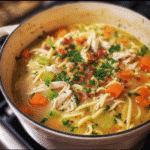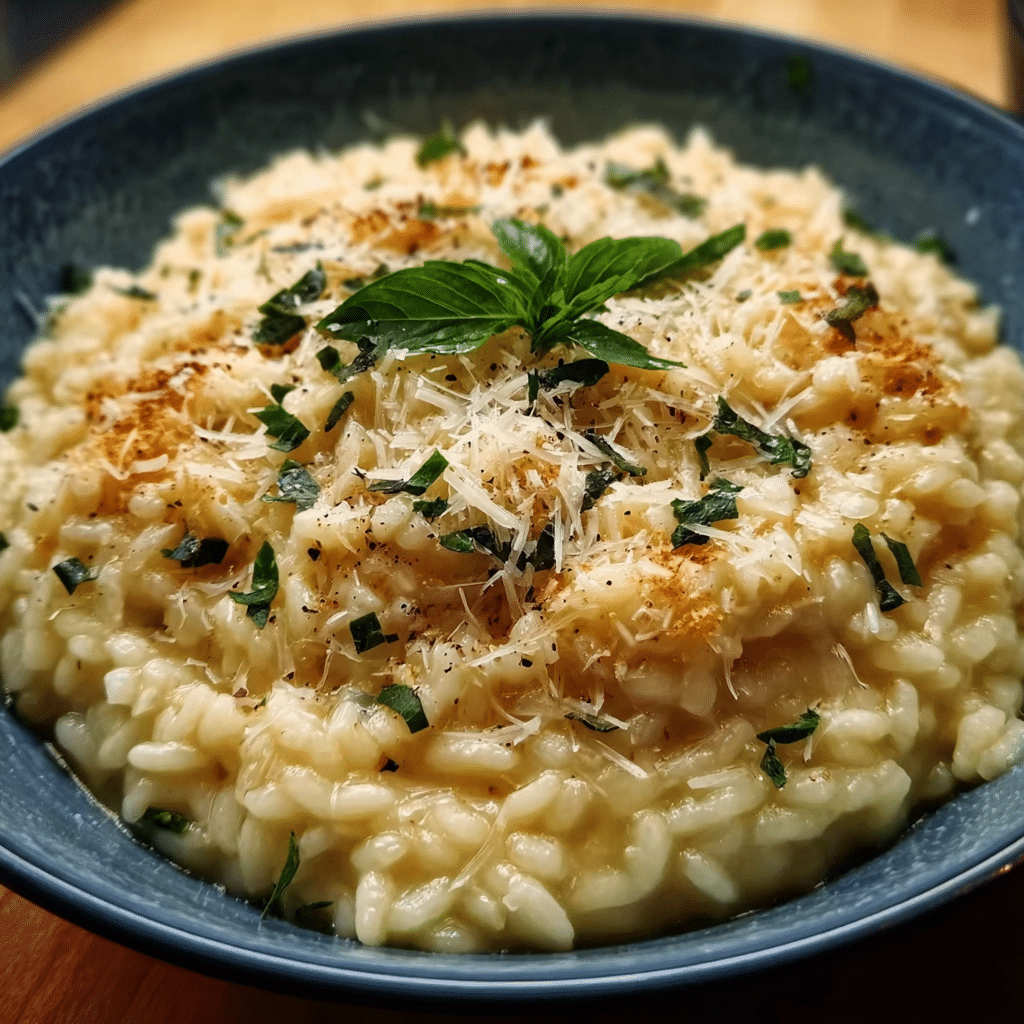Homemade chicken noodle soup is a dish that transcends mere nourishment; it’s a warm embrace on a chilly day, a remedy for a sniffly nose, and a family staple that often carries the weight of cherished memories. My journey with this beloved recipe began in my grandmother’s cozy kitchen, where the aroma of simmering chicken, garlic, and herbs would fill the air, weaving a tapestry of comfort that would envelop anyone who entered. I remember the first time I learned to make it—standing on a stool to reach the counter, my grandmother guiding my hands as we chopped vegetables together, her stories of family dinners echoing in the background.

The beauty of homemade chicken noodle soup lies not just in its ingredients, but in the love and care infused into each bowl. As we stirred the pot, she shared tales of how this dish had been passed down through generations, each family adding a sprinkle of their own tradition. It was in those moments I understood that this soup was more than a recipe; it was a bridge connecting past and present, culture and family, love and nourishment.
The Story Behind This Recipe
Historically, homemade chicken noodle soup has roots deeply embedded in various cultures. From the comforting broths of ancient civilizations to the hearty versions served in bustling markets, chicken soup has been a universal remedy for the soul. In many cultures, it is often prepared for the sick or during the winter months, serving not only as a meal but as a symbol of care. My grandmother’s recipe was influenced by her Eastern European heritage, where chicken soup was a staple, often enjoyed during Sunday family dinners. Each ingredient had a purpose—carrots for sweetness, celery for depth, and noodles to make the dish satisfying.
This recipe is special because it allows for customization while remaining true to its roots. Whether you prefer egg noodles, whole wheat, or even gluten-free options, every family can make it their own. Additionally, it is perfect for busy families looking for quick dinner solutions. With a little preparation, this dish can come together in under an hour, making it ideal for those hectic weeknights. The ability to make a huge batch means leftovers can be enjoyed for days, providing a deliciously comforting meal that warms both the body and soul.
Why You’ll Love This Dish
The seasonal relevance of homemade chicken noodle soup cannot be overstated. While it’s a fantastic dish for fall and winter, I’ve found it to be a delightful choice year-round, especially on rainy days or when I need a pick-me-up. The emotional connection to this dish runs deep. It reminds me of family gatherings, laughter shared over steaming bowls, and the soothing presence of loved ones during times of need. It’s a dish that brings people together, making it a perfect centerpiece for family dinners or a comforting meal for friends.
In this article, you’ll learn everything you need to know about making the perfect homemade chicken noodle soup, from selecting the freshest ingredients to enhancing the flavors with herbs and spices. You’ll discover tips for meal prep, ways to customize the recipe to suit your family’s tastes, and even some tricks for making it in a hurry. This guide promises to be more than just a recipe; it will be your go-to resource for creating a dish that is steeped in tradition and bursting with flavor. So grab your apron and let’s dive into this comforting culinary journey together!
The Rich History and Cultural Significance of homemade chicken noodle
The origins of homemade chicken noodle soup are rich and varied, deeply rooted in culinary traditions around the globe. While it is often associated with American comfort food, its history stretches back to ancient civilizations. The Greeks, Romans, and Chinese all had their unique versions of chicken soup, using it as a remedy for ailments and a source of nourishment. The concept of boiling chicken to extract flavor and nutrients is as old as cooking itself, with each culture adding its own twist.
Origins and History
In the United States, chicken noodle soup gained immense popularity during the Great Depression as a cost-effective way of feeding families. It was a time when stretching a dollar was crucial, and chicken was often the most affordable protein option. Recipes circulated, and families began to develop their own versions, enhancing the simple broth with whatever vegetables they had on hand. This adaptability is what makes homemade chicken noodle soup a staple in countless households today. My own family recipe is a reflection of this evolution, combining traditional elements with modern conveniences.
Regional variations of chicken noodle soup also showcase the diversity of this dish. In the American South, you might find a creamier version with a rich, velvety broth, while in the Midwest, hearty egg noodles are a must. In contrast, Asian cultures have their own interpretations, such as the Vietnamese pho ga, which features rice noodles and aromatic herbs, or the comforting Chinese chicken soup, which emphasizes the use of medicinal herbs. Each variation tells a story of cultural identity and familial love.
Cultural Significance
Throughout history, homemade chicken noodle soup has held a special place in various cultural traditions. It is often served during significant occasions, such as holidays, weddings, and even funerals, symbolizing comfort and care. Many families have their own rituals surrounding the preparation and consumption of this dish—my grandmother would always make a large pot for Thanksgiving, ensuring that everyone had enough to take home, reinforcing the sense of community and togetherness.
Famous chefs and restaurants have also embraced this classic dish, each adding their own flair. Some renowned establishments have elevated chicken noodle soup to gourmet status, infusing it with truffle oil or serving it with artisanal bread. However, the essence of homemade chicken noodle soup remains unchanged—a nourishing, soul-soothing meal that brings happiness to those who consume it.
Nutritional Benefits
Beyond its cultural significance, homemade chicken noodle soup is packed with nutritional benefits. Chicken is a great source of lean protein, essential for muscle repair and overall health. The vegetables add vitamins and minerals, while the broth provides hydration, making it an excellent option when you’re feeling under the weather. Additionally, the warmth of the soup can help soothe sore throats and clear nasal passages, making it a go-to remedy for colds and flu.
In recent years, health-conscious individuals have begun to explore ways to enhance the nutritional profile of their chicken noodle soup. This includes adding superfoods like kale or quinoa, swapping traditional noodles for whole grains or zucchini noodles, and using low-sodium broth to keep the dish light yet flavorful. The versatility of this recipe allows it to be tailored to meet various dietary needs without sacrificing taste.
In conclusion, homemade chicken noodle soup is not just a dish; it is a cultural artifact, a symbol of love and care, and a testament to the importance of food in our lives. Whether you’re revisiting a family recipe or creating a new tradition, this soup will always hold a special place at the table. As we explore the nuances of making this comforting bowl of goodness, I hope you feel inspired to create your own memories around it, just as I did in my grandmother’s kitchen.
Essential Ingredients for Perfect homemade chicken noodle
When it comes to making the perfect homemade chicken noodle soup, the quality and selection of ingredients can make all the difference. Each component contributes not just to flavor, but also to the overall texture and nutritional value of the dish. Let’s dive into the essential ingredients for crafting a warm and comforting bowl of homemade chicken noodle soup.
Essential Ingredients
- 1/2 tablespoon butter: This adds a rich, savory flavor and serves as the base for sautéing the vegetables.
- 2 ribs celery, diced: Celery brings a subtle crunch and a fresh, earthy taste that balances the soup’s richness.
- 3-4 large carrots, diced: Carrots add sweetness and vibrant color, making the soup visually appealing and nutritious.
- 1 clove garlic, minced: Garlic provides depth and aromatic qualities, enhancing the overall flavor profile of the homemade chicken noodle soup.
- 10 cups chicken stock or broth: The foundation of the soup, quality chicken stock is essential for a robust flavor. Homemade stock is preferred, but store-bought works well too.
- 1 teaspoon salt to taste: Salt is key to enhancing all the other flavors in the soup, but it’s important to adjust it based on the saltiness of your broth.
- 1/2 teaspoon freshly ground black pepper to taste: Black pepper adds a slight heat and complexity to the dish.
- 1/8 teaspoon dried rosemary or more to taste: Rosemary introduces a fragrant herbal note that complements the chicken beautifully.
- 1/8 teaspoon dried thyme: Thyme is another aromatic herb that pairs well with chicken and adds depth to the broth.
- 1/8 teaspoon crushed red pepper flakes: For those who like a little kick, these flakes can elevate the soup’s flavor.
- 1 batch homemade egg noodles or 4 cups dry egg noodles, farfalle or other bite-size pasta: The noodles are the heart of the homemade chicken noodle soup, providing substance and texture.
- 3 cups rotisserie chicken: This is a convenient option that offers rich flavor and tender meat. Feel free to use leftover roasted chicken too!
- 1 teaspoon Better than Bouillon chicken flavor or more as needed or chicken bouillon granules: This adds an extra layer of flavor and richness to the broth.

Homemade Chicken Noodle Soup Recipe
Ingredients
- 1 tablespoon butter
- ½ cup chopped onion
- ½ cup chopped celery
- 4 (14.5 ounce) cans chicken broth
- 1 (14.5 ounce) can vegetable broth
- ½ pound chopped cooked chicken breast
- 1 ½ cups egg noodles
- 1 cup sliced carrots
- ½ teaspoon dried basil
- ½ teaspoon dried oregano
- salt and ground black pepper to taste
Instructions
- Melt butter in a large pot over medium heat. Add onion and celery and cook until just tender, about 5 minutes.
- Add chicken broth, vegetable broth, chicken, egg noodles, carrots, basil, oregano, salt, and pepper. Stir to combine and bring to a boil.
- Reduce heat and simmer for 20 minutes.
Shopping Tips
When selecting ingredients for your homemade chicken noodle soup, freshness is key. Always look for vibrant vegetables—carrots should be firm and bright orange, while celery should be crisp. If you’re buying chicken, opt for organic or free-range options when possible, as they tend to have better flavor and texture. For chicken stock, homemade is ideal, but if you’re getting store-bought, choose low-sodium varieties to control the salt content. When it comes to herbs, fresh ones can elevate your soup, but dried herbs are perfectly fine and more convenient. Check expiration dates to ensure freshness.
Substitutions and Alternatives
If you have dietary restrictions or simply want to customize your homemade chicken noodle soup, there are plenty of substitutions you can make. For a vegetarian version, swap the chicken stock for vegetable broth and use tofu or chickpeas instead of chicken. For gluten-free options, substitute egg noodles with gluten-free pasta varieties or even zucchini noodles. If you’re watching your sodium intake, consider using no-salt-added chicken broth and omitting the bouillon. Finally, if fresh herbs are unavailable, you can use dried herbs, but remember that dried herbs are more potent, so use them sparingly.
In terms of storage, make sure to keep your vegetables in a cool, dry place to maximize their shelf life. Leftover rotisserie chicken can be stored in the refrigerator for up to four days or frozen for later use. Homemade noodles can be dried and stored in an airtight container, while any extra soup can be refrigerated for up to a week or frozen for several months.
By carefully selecting each ingredient and considering substitutions based on personal preferences, you can ensure that your homemade chicken noodle soup is not only delicious but tailored to your taste and dietary needs.
Detailed Step-by-Step homemade chicken noodle Cooking Instructions
Creating a delightful bowl of homemade chicken noodle soup is not just about the ingredients; it’s also about the method and the love you put into the cooking process. This recipe will guide you step by step, ensuring that your soup is not only flavorful but also comforting, which is what a great chicken noodle soup is all about.
Preparation Steps
- Gather Your Ingredients: Before you start cooking, assemble all your ingredients. This is known as mise en place, a French culinary term meaning “everything in its place.” Having everything ready will streamline the cooking process.
- Prepare the Vegetables: Dice the celery and carrots into small, even pieces to ensure they cook uniformly. Mince the garlic. If you’re using homemade egg noodles, prepare them according to your recipe, or if you’re using store-bought, have them ready to go.
- Shred the Chicken: If you’re using rotisserie chicken, take the meat off the bone and shred it into bite-sized pieces. This step can be done while the vegetables are cooking to save time.
Cooking Process
- Sauté the Aromatics: In a large pot, melt the butter over medium heat. Once melted, add the diced celery and carrots. Sauté for about 5-7 minutes until the vegetables begin to soften. The aroma will be delightful, signaling that you’re on the right path.
- Add the Garlic: Stir in the minced garlic and sauté for an additional minute. Be careful not to burn the garlic, as it can turn bitter. You want it to be fragrant and slightly golden.
- Pour in the Chicken Stock: Slowly add the chicken stock to the pot. As you pour, scrape the bottom of the pot with a wooden spoon to deglaze it, picking up any delicious bits stuck to the bottom.
- Season the Broth: Add in the salt, black pepper, dried rosemary, thyme, and crushed red pepper flakes. Stir well to combine. Taste the broth and adjust the seasoning as needed. Remember, you can always add more, but you can’t take it out!
- Add the Chicken: Gently fold in the shredded rotisserie chicken. This will add layers of flavor and protein to your soup.
- Cook the Noodles: If using homemade noodles, add them at this stage to cook in the broth for about 5-7 minutes. If using dry noodles, refer to the package instructions for cooking time, usually around 8-10 minutes. Stir occasionally to prevent sticking.
- Add Bouillon (if needed): Depending on your taste and the strength of your broth, you may want to add the Better than Bouillon or bouillon granules at this time. Stir until dissolved.
- Simmer and Serve: Let the soup simmer for another 5 minutes to allow all the flavors to meld together. Check the seasoning one last time before serving. The soup should be hot, fragrant, and ready to enjoy!
Final Assembly
Once your homemade chicken noodle soup is ready, it’s time to serve it up. Ladle the soup into bowls, making sure to include a good amount of noodles and chicken in each serving. For an extra touch, you can garnish with fresh herbs like parsley or thyme. Serve with crusty bread or crackers on the side for a complete meal. Enjoy the warmth and comfort of your homemade chicken noodle soup, and don’t hesitate to share it with family and friends. After all, good food is meant to be shared!
As you enjoy your soup, take a moment to appreciate the process. Each step, from chopping vegetables to stirring the pot, is part of a beautiful tradition that has been passed down through generations. Whether you’re making this soup on a chilly winter evening or when feeling under the weather, the love and care you put into it will always shine through in the final dish.
Professional Tips and Techniques for homemade chicken noodle
When it comes to making a comforting bowl of homemade chicken noodle soup, there are some professional tips and techniques that can elevate your dish from ordinary to extraordinary. Drawing from my own experiences in the kitchen, I’ve learned that a few insider secrets can make all the difference in flavor, texture, and presentation. Let’s dive into these valuable insights that will not only help you master the art of homemade chicken noodle soup but also make the cooking process enjoyable!
Professional Techniques
One of the key techniques for a truly flavorful homemade chicken noodle soup is the process of building layers of flavor. Start by using a combination of aromatics such as onions, garlic, carrots, and celery. Sauté these in a bit of olive oil or butter before adding your chicken and broth. This step releases essential oils and natural sugars, enriching the overall taste of your soup.
Another important technique is to use high-quality ingredients. Whether you’re using a store-bought broth or making your own, the quality of the broth can significantly affect your soup’s flavor. If you have time, I highly recommend making a homemade broth by simmering chicken bones with vegetables and herbs. This not only adds depth to your homemade chicken noodle but also fills your kitchen with a mouthwatering aroma that will have everyone eagerly awaiting the meal.
For those looking to enhance their cooking skills further, consider investing in some key kitchen tools. A good quality chef’s knife is essential for chopping vegetables efficiently, while a sturdy stockpot is necessary for simmering your soup. A fine-mesh strainer can be useful if you’re straining homemade broth, and a wooden spoon is perfect for stirring without scratching your pots. These tools not only make the cooking process smoother but also contribute to the quality of your final dish.
Troubleshooting Guide
Even the most experienced cooks encounter challenges while preparing homemade chicken noodle soup. One common issue is ending up with bland soup. If you find your soup lacking flavor, consider adjusting the seasoning. Adding salt gradually while tasting can help you find the perfect balance. Also, a splash of lemon juice or a dash of vinegar can brighten the flavors significantly.
Another common problem is overcooked noodles. To prevent this, consider cooking the noodles separately and adding them to individual bowls before ladling the soup over them. This way, you have more control over the texture, ensuring that they’re perfectly al dente every time.
For those who may find their soup overly greasy, skim the fat from the surface with a spoon or use a fat separator after cooking your chicken. This simple step can enhance the soup’s overall quality and make it feel lighter on the palate.
Presentation Tips
Presentation can elevate your homemade chicken noodle soup from a simple comfort food to a beautiful meal. Consider garnishing your soup with fresh herbs like parsley or dill to add a pop of color and freshness. A sprinkle of freshly cracked black pepper can also enhance the visual appeal while adding a subtle bite.
When serving, opt for rustic bowls that complement the warm, inviting nature of the soup. Pair your soup with a side of crusty bread or a simple salad to create a well-rounded meal. If you’re feeling extra creative, you can even serve your soup in hollowed-out bread bowls for a fun twist!
Don’t forget about beverage pairings. A light white wine, such as Sauvignon Blanc, complements the flavors of homemade chicken noodle beautifully, while a herbal tea can enhance the comforting experience. If you’re serving this soup during a cozy gathering, consider offering a selection of beverages that align with the warmth and heartiness of your dish.
Lastly, for meal prep enthusiasts, homemade chicken noodle soup is a fantastic make-ahead option. Prepare a large batch and store it in the refrigerator or freezer for future meals. When scaling the recipe, keep in mind that the cooking time may need to be adjusted based on the volume. This flexibility allows you to enjoy a comforting bowl of soup whenever the craving strikes!

Creative Variations and Adaptations of homemade chicken noodle
Homemade chicken noodle soup is a classic dish that invites creativity. As much as I love the traditional version, there are countless ways to adapt and enhance this beloved recipe. From seasonal ingredients to dietary modifications, let’s explore the exciting variations and adaptations you can try, all while keeping the essence of homemade chicken noodle soup alive!
Seasonal Variations
One of the joys of making homemade chicken noodle soup is that it can be tailored with seasonal ingredients. In the spring, consider adding fresh asparagus or peas for a bright, vibrant touch. During the fall, switch out the traditional carrots for roasted butternut squash for a sweeter twist. In the winter months, you can incorporate hearty greens like kale or Swiss chard to give your soup a nutrient boost and a pop of color.
Additionally, using herbs that reflect the season can enhance the flavor profile significantly. Fresh thyme is amazing in the fall, while basil shines in the summer. This adaptability not only keeps your soup exciting but also allows you to take advantage of the freshest produce available.
Dietary Adaptations
With the growing popularity of various dietary lifestyles, it’s important to offer modifications that cater to different needs. If you’re looking to make a keto-friendly version of homemade chicken noodle soup, simply replace traditional noodles with spiralized veggies such as zucchini or shirataki noodles. These alternatives provide the same comforting feel without the extra carbs.
For those following a vegan diet, you can easily create a plant-based version by omitting the chicken and using vegetable broth instead. Replace the chicken with hearty ingredients like chickpeas or tofu for added protein, and don’t forget to add umami-rich ingredients like mushrooms to deepen the flavor.
Gluten-free adaptations are also simple to implement. Use gluten-free noodles or even rice for a delicious alternative that stays true to the essence of homemade chicken noodle soup. Always check labels to ensure that all your ingredients are gluten-free, especially when using packaged broth or noodles.
Creative Twists
If you’re feeling adventurous, there are many creative twists you can add to your homemade chicken noodle soup. For a spicy kick, consider adding a splash of hot sauce or a sprinkle of red pepper flakes. Alternatively, for a touch of international flair, try incorporating Asian flavors like ginger, soy sauce, and sesame oil. This fusion not only brings a unique taste but also introduces new textures to your soup.
Different cooking methods can also yield exciting results. If you prefer a slow-cooked version, use a slow cooker to allow the flavors to meld over several hours. Alternatively, an Instant Pot can provide a quick and convenient way to achieve a rich, homemade flavor in a fraction of the time.
Leftovers can be transformed into new meals as well. Consider using leftover soup as a base for a casserole or even as a filling for pot pies. The possibilities are endless, and it’s a delightful way to reduce food waste while creating new culinary experiences!
In conclusion, the beauty of homemade chicken noodle soup lies in its versatility. By experimenting with seasonal ingredients, dietary modifications, and creative twists, you can tailor this classic dish to suit your taste and lifestyle. So, roll up your sleeves, gather your ingredients, and get ready to enjoy a nourishing bowl of homemade chicken noodle soup that’s uniquely yours!
Storage, Reheating, and Meal Prep for homemade chicken noodle
When it comes to enjoying the comforting embrace of a steaming bowl of homemade chicken noodle soup, knowing how to properly store it can make all the difference. I remember the first time I made this soup; the aroma filled my kitchen, and I found myself daydreaming about all the cozy dinners ahead. But then came the question: how do I keep this delicious soup for the days to come? Here’s everything you need to know about storing, reheating, and prepping your homemade chicken noodle for maximum enjoyment.
Short-term Storage
After you’ve whipped up a batch of homemade chicken noodle soup, you’ll probably want to savor it over a few days. The key to short-term storage is to allow your soup to cool completely before transferring it into storage containers. I often use glass containers with airtight lids; they prevent spills, and I love that I can see the soup through the glass. If you’re using plastic containers, make sure they are BPA-free and designed for food storage.
For best practices, divide the soup into smaller portions. This not only makes it easier to reheat but also reduces the time the soup spends at room temperature, which is crucial for food safety. I typically portion out 1-2 servings in each container, allowing me to take out just what I need without having to heat the entire batch again.
Store your homemade chicken noodle soup in the refrigerator if you plan to eat it within 3-4 days. It’s important to keep the temperature of your refrigerator at or below 40°F (4°C) to inhibit the growth of bacteria. Make sure to label the containers with the date, so you can keep track of the freshness.
Freezing and Long-term Storage
What if you want to save some of that delicious homemade chicken noodle soup for a rainy day? Freezing is a fantastic option! First, let your soup cool down completely before transferring it to freezer-safe containers or heavy-duty freezer bags. If you’re using bags, lay them flat in the freezer. This not only saves space but also allows for quicker thawing later on.
It’s best to freeze the soup without the noodles, as they can become mushy and lose their texture when thawed. Simply cook some fresh noodles when you’re ready to enjoy your meal. If you do choose to freeze with noodles, consider undercooking them slightly so they hold up better when reheated.
In terms of shelf life, your homemade chicken noodle soup can last in the freezer for up to 3 months. After that, while it may still be safe to eat, the quality can start to decline. I recommend using a permanent marker to write the date on the container or bag to avoid any confusion later on.
Reheating Best Practices
Reheating your homemade chicken noodle soup can be just as important as how you store it. The goal is to warm it through without compromising its flavor or texture. If you stored the soup in the refrigerator, you can reheat it on the stovetop over medium heat. Stir occasionally to ensure even heating and prevent sticking. If you find that the soup has thickened, add a splash of chicken broth or water to restore its original consistency.
For frozen soup, the best method is to thaw it in the refrigerator overnight before reheating. If you’re in a hurry, you can use the microwave. Just transfer the soup to a microwave-safe bowl, cover it loosely, and heat on high in 1-minute intervals, stirring in between, until heated through.
Remember, food safety is paramount. Always ensure your soup reaches a minimum internal temperature of 165°F (74°C) before serving. This is particularly important if the soup has been frozen. Over the years, I’ve learned that there’s nothing worse than a lukewarm soup, especially when you’re craving that heartwarming taste of homemade chicken noodle!

In summary, storing your homemade chicken noodle soup effectively allows you to enjoy it over several days or even weeks. By following these guidelines on short-term storage, freezing, and reheating, you can savor every last drop of this comforting dish. Whether you’re enjoying it fresh or reheated, it’s sure to bring warmth and joy to your table!
Nutritional Benefits and Health Information
As much as homemade chicken noodle soup is about comfort and nostalgia, it’s also a dish packed with nutritional benefits. Growing up, my grandmother used to say that soup was not just food; it was medicine. I’ve come to understand that there’s truth in that statement, especially when it comes to the wholesome ingredients we use to create this beloved dish. Let’s delve into the nutritional profile, health benefits, and dietary considerations of this classic comfort food.
Nutritional Profile
A typical serving of homemade chicken noodle soup—let’s say about one cup—contains a balance of proteins, carbohydrates, and fats, making it a well-rounded meal option. On average, you can expect it to provide around 200-300 calories, depending on the specific ingredients and quantities used.
In terms of macronutrients, you’ll find approximately 10-15 grams of protein from the chicken, which is essential for muscle repair and immune function. The noodles contribute around 30-40 grams of carbohydrates, providing energy. While the soup is generally low in fats (often less than 10 grams), you can adjust this by adding ingredients like olive oil or butter for a richer flavor.
Micronutrient-wise, homemade chicken noodle soup can be a treasure trove of vitamins and minerals. Depending on the vegetables you add, you might be looking at significant amounts of Vitamin A, Vitamin C, and various B vitamins, along with important minerals like potassium and magnesium. The chicken itself is a great source of selenium, which plays a crucial role in metabolism and thyroid function.
Health Benefits
The health benefits of homemade chicken noodle soup are vast. The combination of chicken and vegetables provides a nutrient-rich base that can help support overall health. Chicken is not only a lean protein source but also contains amino acids that help build and repair tissues. Additionally, the warmth of the soup can soothe sore throats and provide comfort during cold and flu season.
Studies suggest that chicken soup may have anti-inflammatory properties. Ingredients like garlic and onion, often included in the recipe, can act as natural immune boosters. I always add a generous amount of garlic; it adds depth to the flavor and a health-boosting punch. Plus, the broth itself is hydrating and can help keep you feeling full, making it a great option for weight management.
Dietary Considerations
When considering dietary restrictions, homemade chicken noodle soup is quite versatile. For those who are gluten intolerant, you can easily swap traditional egg noodles for gluten-free alternatives made from rice or quinoa. Additionally, if you’re looking to make the soup vegetarian or vegan, simply omit the chicken and use vegetable broth as a base, adding other protein sources like beans or lentils for a hearty meal.
For those watching their sodium intake, making soup at home allows you to control the amount of salt that goes into it. Using low-sodium chicken broth and fresh herbs can add flavor without the extra sodium. It’s a fantastic way to enjoy the comforting flavors of soup without compromising health.
In terms of calories, a serving of homemade chicken noodle soup can fit into various diet plans, including Mediterranean, paleo, or even keto if you modify the noodles. For instance, you can add more vegetables and reduce the noodles to create a lower-carb option, making it suitable for those on a keto diet.
In conclusion, homemade chicken noodle soup is more than just a comforting dish; it’s a nutritional powerhouse that has been enjoyed for generations. By understanding its health benefits and dietary considerations, you can make informed choices that align with your health goals while still indulging in the rich, flavorful experience of a bowl of soup. So the next time you ladle out a serving of this classic dish, remember that you’re not just nourishing your body, but also continuing a time-honored tradition of comfort and care.
Frequently Asked Questions About Homemade Chicken Noodle
Easy chicken noodle soup recipe
For an easy chicken noodle soup recipe, start by sautéing chopped onions, carrots, and celery in a pot until they soften. Add diced chicken (preferably boneless, skinless) along with low-sodium chicken broth and bring to a boil. Once boiling, add egg noodles and cook until tender, about 7-10 minutes. For added flavor, season with salt, pepper, and your choice of herbs like thyme or parsley. Finally, serve hot and enjoy the comforting taste of homemade chicken noodle soup!
Chicken noodle soup Jamie Oliver
Jamie Oliver’s chicken noodle soup recipe emphasizes fresh ingredients and vibrant flavors. He suggests using a whole chicken to make a rich broth, which can be enhanced with aromatic herbs like rosemary and bay leaves. After boiling the chicken, shred the meat and return it to the pot along with the noodles and seasonal vegetables such as peas or spinach. To elevate the dish, finish with a squeeze of lemon juice and fresh herbs for a burst of brightness. This approach not only adds depth to the soup but also makes it a nourishing meal for any occasion.
Best chicken noodle soup recipe
The best chicken noodle soup recipe often combines a homemade broth with quality ingredients. Start by roasting chicken bones or using a whole chicken to create a rich base, simmering it with aromatics like onion, garlic, and celery. After straining the broth, return it to the pot and add fresh vegetables, your favorite noodles, and shredded chicken. For an extra touch, consider incorporating a dash of soy sauce or Worcestershire sauce for umami flavor. Let everything simmer until the noodles are cooked, and finish with freshly chopped herbs for a fragrant and delicious soup.
Simple chicken soup recipe
A simple chicken soup recipe can be made with just a few pantry staples and fresh ingredients. Begin by boiling chicken thighs or breasts in water with salt, pepper, and any herbs you have on hand, such as thyme or parsley. Once the chicken is cooked, remove it from the pot, shred it, and set it aside. In the same broth, add chopped vegetables like carrots and potatoes, cooking until tender, then reintroduce the chicken and add noodles if desired. This straightforward recipe is versatile and can be adjusted based on your taste preferences and available ingredients.





